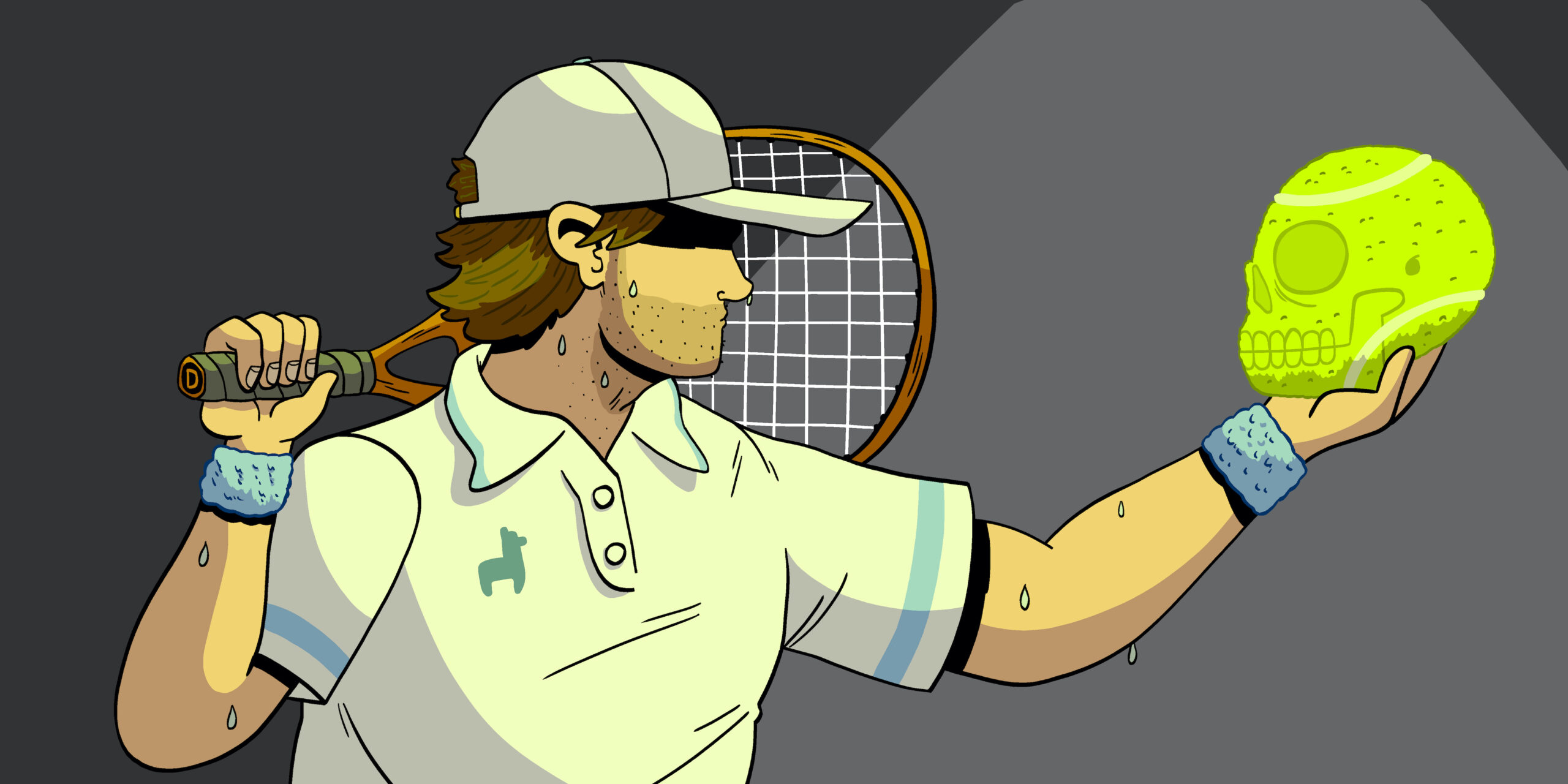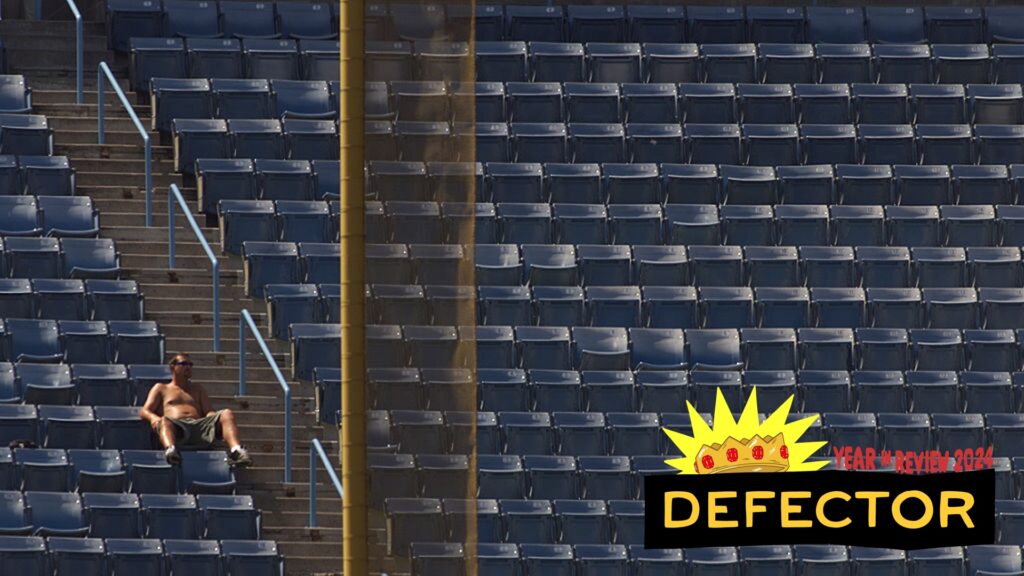The best way to snap an athlete out of platitude autopilot in a press conference is to get them to vent about some technical complaint. Like everyone else, they have esoteric gripes about their workplace, and are happy to explain them in full when given the chance. During my time at the ATP Finals, a year-end tournament in Italy for the top of the men’s tour, I asked several players to reflect on the object they clobber all day.
Complaints about the tennis ball are a staple of both the men’s and women’s tours, though the exact nature of the complaint has changed over time. The type of ball varies between tournaments, which is a common source of consternation. Before the 2022 U.S. Open, eventual champion Iga Swiatek said the balls used were “horrible,” and wondered why the women couldn’t use the fluffier “extra duty” Wilson balls used by the men at that tournament. Ashleigh Barty, who won three different majors before retiring suddenly at age 25, never figured out the U.S. Open. Her coach Craig Tyzzer once said—somewhat bizarrely on the day of her Australian Open title—that Barty would never win the U.S. Open unless they changed the ball.
This more recent bout of ball-bashing began, as most good tennis conversations do, with current world No. 5 Daniil Medvedev, the tour’s most compelling talker and its most fluent in the language of complaint. In Turin, he emerged as a promising candidate for questioning as I watched him sink into nihilism during his opening-match loss to current world No. 4 Taylor Fritz. Medvedev has a track record of charmingly cartoonish melodrama, and a real commitment to every bit, but he generally stops short of self-sabotage. Holding the racquet backward was extreme, even for him.
So why had Medvedev given up hope this time? He felt the tennis balls were different than they used to be, and the change had sapped tennis of its old joy. “I have this every day, day in, day out, since like two, three years,” he said after the 6-4, 6-3 loss to Fritz. “Every practice is a struggle. Every match is a struggle. I was holding [serve] for long time. Now I feel zero pleasure of being on the court.”
While Medvedev was the most consistent objector, this had become a sporadic gripe on the men’s tour, so I asked as many players as I could during that week in November. The ball-bashers had a few interwoven complaints: Different tournaments use different brands, making it annoying to switch between different balls from week-to-week; a single manufacturer’s balls can vary vastly in quality from can to can; and, most interestingly, the quality of all tennis balls has become worse across the board.
Medvedev was making that last claim. He said that players first noticed a change after the pandemic: It had become harder to make the ball move quickly through the air. Medvedev had a rough 2022 season that prompted a change to softer racquet strings in 2023, allowing him to increase the speed on his shots to compensate for what he’d lost. This fix worked for a while, but once again, Medvedev felt that he’d lost his competitive advantage. He used to be one of the most brilliant counterpunchers in the game, using his peculiar combination of wingspan and foot speed to demoralize opponents, retrieving unlikely balls from miserable court positions. With the ball moving slower, and players getting to those balls more easily, his defense was not so special anymore. “Literally everyone can stay in the rally with me right now,” he said. “Tactics matter less. It’s just about fighting and serving well.”
By way of illustration, Medvedev talked me through a specific point in a recent match he’d played against Matteo Arnaldi at the Shanghai Masters. He was hitting a passing shot from deep behind the baseline, which is an area of the court where he typically feels quite comfortable. “The moment I hit the ball, I am like, ‘Wow, that’s [an] amazing shot.’ I could feel it,” Medvedev said. “[Arnaldi] made a very good volley. Normally he should not be on the ball—it should be a winner. But the ball dies in the air. When I return from five meters back, at the end [of its flight], the ball literally stops, so the guy has time to attack me.” After winning the match, the perma-sarcastic Medvedev wrote “Nice balls” on the camera.

Medvedev theorized that the current balls favor players like Carlos Alcaraz and Jannik Sinner, who can attack a “dead ball” with enough power to ensure it still moves through the air at an unreturnable speed. Ultimately, Medvedev acknowledged that he was (at that time) No. 4 in the world and doing fine for himself. He said he planned to regroup with his team to figure out the necessary adjustments for 2025.
Even though Medvedev was a charismatic complainer, that didn’t mean the complaint had real merit. I had to check in with his colleagues, too. In press later in Turin, I asked a similar question to current world No. 2 Alexander Zverev, who revealed he’d deeply researched the ball issue in his capacity as a rep on the ATP players’ council. He claimed to have “called up companies” and learned that the quality of materials had gone down across all manufacturers.
A tennis ball is a pressurized rubber ball with an outer felt coating. It’s normal for them to move slower through the air as that felt gets worn out and fluffier, increasing air resistance. This is why you’ll see players rifle through a few balls before they serve, in search of one with the least poofy felt. But that’s not what Zverev was worried about. He believed that the balls are losing their internal pressure due to the inferior material. He also believed that there was a link between these lower-quality balls and injury—players exerting more effort to hit those balls harder were picking up elbow and wrist issues, which he said was something you didn’t see as often 10 or 15 years ago. I trust players to know their workplaces, but it would be difficult to check this more rigorously, since injuries on the tour are not reported and compiled in any systematic way.
Zverev’s claim that he had studied companies and confirmed a decline in material quality was intriguing. I reached out to tennis ball manufacturers for comment. Wilson and Dunlop, two of the main ball suppliers for the ATP, did not reply to my requests for an interview. But in December I was able to arrange a video call with a representative at Head, the parent company of Penn, which produces the balls used in Indian Wells. Jeff Bardsley, a vice president of marketing at Penn, spoke frankly about the challenges faced by both tennis ball suppliers and tennis players. He walked me through some supply issues they’d faced over the last few years, but he seemed to think that the ball had become a scapegoat when other technological and scheduling factors were more to blame for player malaise.
“It has been a little bit of a challenge for us as tennis ball suppliers, because the last thing in the world we want to do is create a ball that, number one, the players don’t like. Number two, they get on camera and literally hold up the brand of the ball and say, ‘This ball is shit.’ Which we’ve seen from a couple players,” Bardsley said, smiling.
To create a tennis ball, two separate rubber ball halves are filled with compressed air and fused under high temperature with a heat-activated glue. The resulting rubber sphere is abraded, then coated in a different glue, then wrapped in flaps of that yellow-green felt covering. A third glue, applied to the edges of the felt, forms the white seams we see on the surface of the ball. Bardsley conceded that the company did navigate challenges from mid-2020 through the end of 2023, when demand for tennis balls spiked due to the increase in recreational tennis, but production itself was compromised due to the pandemic.
Rubber and felt companies were struggling to retain workers and keep up their consistency during the pandemic, Bardsley said. At one of their factories in China, one person got sick, shutting down the whole factory for two weeks. “So at that state, there was inconsistency in our line operations,” he said. “I mean, we had some challenges, there was no question about it. Anything where the demand surges that high, and factories try to keep up with that demand, there’s going to be some challenges in terms of quality. As much as we want to keep it, there’s going to be some challenges in terms of the raw materials that we’re sourcing.” Other factors Bardsley mentioned included additional demand for rubber, as the sport of padel surged in Europe, and the freight issues that many companies faced during the pandemic.
When asked if any of those factors could be affecting how Penn balls played during the 2024 season, Bardsley said those issues had been resolved by the end of 2023, and the company had returned to its regular standard of rubber and felt. “We’re coming out on the other side, there’s no question about it.” In an interview on the Tennisnerd podcast, Mauro Pinaffo, senior global product manager for tennis and padel balls at Head, said that “more or less” all tennis brands buy felt from the same two suppliers. While the quality of that felt became inconsistent during the pandemic, Pinaffo said they had solved the issue by treating the felt with “temperature and steam” to control how much it fluffed up.
Bardsley also noted that quality control is even more stringent when the company is creating balls for the pro tour to use. During our December conversation, he said that Penn had just finished manufacturing its batch of balls for Indian Wells, which will be played in March 2025. “As opposed to going through five to seven quality control checks on a regular run, it goes through basically 15,” he said. “And there’s also what we call a ‘higher overage.’ If Indian Wells needs 1,000 cases of balls, we’ll produce 1,200 cases of balls, and basically the testing becomes more rigorous. The balls that we’re actually producing and shipping to the tournament pass through a higher quality-control process. So there’s more consistency in the actual ball.”
Bardsley speculated that variation in temperature, humidity, and altitude are bigger culprits when it comes to the lack of consistency in how the ball plays. So too is the grit on the court surface. It can cause the ball to fluff up with friction. It can even “exfoliate” the ball, to use their lovely term of art, leaving the court surface strewn with neon fuzz.
Asked specifically about Zverev’s idea that the ball is losing its internal pressure, Bardsley said there’s testing for that, too. “We have an actual gun—we call it the ball cannon—and [the ball] gets launched against a hard court or a clay court surface or a grass court surface, and we basically simulate, in most cases, about 30 minutes of solid hard play at an ATP level. So there’s a service cannon, and there’s a regular ball cannon where it actually simulates ground strokes, but the balls are tested and the balls are expected [to last],” he said. In another test, two plates squeeze together and compress the ball. “We have specifications—that ball has got to go under a certain amount of compression, a certain amount of time exerted on it, before it splits.”
Bardsley doesn’t deny that the balls can go flat; in the modern game, the players are hitting so hard that they can threaten the integrity of the rubber core. But he suspected that once the core is crushed and starts to leak air, those balls are quickly noticed by the players and brought to the umpire to be swapped out. It’s jarring enough to be immediately remedied.
As for player injuries, Bardsley believed it had nothing to do with the ball and a lot to do with the game’s increased power and less forgiving racquet tech. “You’re now playing with a polyester string, which has absolutely no give,” he said. “You’re playing with stiffer flexing racquets, that are narrower beam, that aren’t generating a lot of additional sweet spot, a smaller head-sized racquet, and a heavier racquet. So, the combination of all those things.”
The remaining players in Turin were less passionate than Zverev and Medvedev about tennis balls, but had their own reads on the situation. Casper Ruud, a clay specialist who played some uncharacteristically good tennis on the fast indoor hard courts that week, told me that he liked some amount of variation in the ball between tournaments, because it suits different styles of play. But on the whole, Ruud did call for “somewhat more consistency with the ball” across tournaments.
Alex de Minaur, a slender speed demon who broke out in 2024 by adding a bit more offensive firepower, wouldn’t comment on which particular ball he liked most. “But what I do believe—there’s got to be a way better schedule with balls, right? You can’t be playing different weeks with different balls back-to-back, in my eyes,” he said. “In an ideal world, I think you play everywhere with the same ball.”
Taylor Fritz, the big-serving American winding down the best season of his career, began by saying that he couldn’t remember what balls were like before 2020, but then talked himself into some fairly nuanced opinions. He recalled that the Wilson U.S. Open balls played drastically different in back-to-back weeks in 2023. “You just could not tell me those were the same balls we were playing with both weeks,” Fritz said. “There’s just no chance. In Cincinnati, they were going hairless. In Montreal, they were puffing up like they normally do.”
Fritz echoed a bit of the “dead ball” sentiment from Medvedev and Zverev. “I do feel like certain balls have been getting into the tournament rotation a bit more often the last couple years that just play a lot slower,” he said. “They’re a lot softer. They feel more dead. A good example is the Wilson balls we used in Laver Cup and Shanghai. They feel great. You feel like you literally can’t miss a ball. But they’re very soft. It’s almost like playing with a ‘green dot’ [child’s training] ball. Hard to hit a winner. Those balls are probably only acceptable to play on a really fast court.”
The only man who was quite as doleful as Medvedev was his dear friend and countryman, Andrey Rublev. The pure power hitter echoed Medvedev’s Nietzschean pronouncement that tactics are dead. He also didn’t really care.
“I don’t know if the courts change a lot or the balls, but something changed,” Rublev said. “Maybe both, I don’t know. It changed that much that I don’t really care anymore, because doesn’t matter which balls you play, it’s tough to control them. You feel you do more or less the same shots, and the ball fly different.
“When I was starting, it was like you could feel the tactic, you could feel you need to play like that, like this, you need to choose the right directions. Now with tennis that we have, it’s two shots, one serve, one shot,” Rublev said. “Even if you have tactic, is not working anymore because you go play against a player like Sascha [Zverev], he serves like 220 [km/hr], then next shot he play other side. Doesn’t matter the tactic you choose, you’re not able to do it.”
Rublev, who often speaks about professional tennis as if it is a dungeon that torments him, seemed wistful for the earlier days of his career. “When I was starting, I don’t know if it was the balls or something, but I remember in the past there was really many good balls,” he said. “The feeling was like the more you accelerate, more control you have. Now you feel sometimes the more you accelerate, the ball can go amazing, the next ball can go five meters south. It happens to every player. I guess that’s why many of them complain.”
It’s hard to know what to make of all this. These are subtle questions of feel, and some remarks from respondents are hard to reconcile with others. Medvedev and Rublev both seemed to think that “tactics” were gone in men’s tennis, but for nearly opposite reasons: Everybody can rally forever, or nobody can rally for two shots. Those two particular players, both susceptible to fits of stagy melancholy, are also trying to figure out week after week how to beat twin dynamos Carlos Alcaraz and Jannik Sinner, whose youthful presence endangers their own career prospects. Is it easier to stomach a professional decline by building a theory that the game has changed structurally to favor some other set of players? Possibly.
Whatever the case, the ATP has heard enough and says it’s already working to create more consistency in the calendar. “We have centralized for the first time the process of which balls are used in tournaments to avoid them changing every week,” ATP chairman Andrea Gaudenzi told the Italian journalist Marco Iaria in Turin. “Execution takes 1-2 years because previous commercial contracts have to expire. That’s why players still complain. Then there is an issue of specifications and quality standards to give, we are working on that.”
After all, the ball is just one factor, and it’s already produced according to narrow specifications from tennis’s governing bodies. I am willing to entertain Bardsley’s idea that court surface and environmental conditions have a greater impact on how the ball plays than any supposed variation in ball quality. I am also, however, open to critiques from tennis gear aficionados who have noticed declines in ball quality across several brands. Unlike the pros, rec players tend not to be globe-trotting between sessions, so there aren’t as many environmental variables to blame.
As for the guys playing on TV, I wonder if some of the changes in game style they decry have just as much to do with factors beyond the balls, such as the advances in technique or strength and conditioning that enable the likes of Alcaraz and Sinner to hit as big as they do on every single shot. I also wonder if I’d helped to bring their malaise into existence by raising the topic of the ball at all. These characters spend a lot of time in their own heads, and they are prone to stewing, sometimes dredging up years-old complaints from the muck. Tennis players can find a way to become neurotic about anything: noise, bathroom breaks, crowd movement, court grooming, officiating, towels, coaching, a lack of coaching. Perhaps when you gather some of them in one place and prod them for answers, these obsessively detail-oriented, high-performance athletes will project their anxieties onto something small, spherical, and entirely outside their control.

 Workout
Workout
 Meditation
Meditation




 Contact Us
Contact Us










